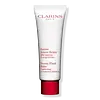What's inside
What's inside
 Key Ingredients
Key Ingredients

No key ingredients
 Benefits
Benefits

 Concerns
Concerns

 Ingredients Side-by-side
Ingredients Side-by-side

Water
Skin ConditioningParaffinum Liquidum
EmollientStearic Acid
CleansingGlyceryl Stearate
EmollientTriethanolamine
BufferingCera Alba
EmollientCetyl Palmitate
EmollientButyrospermum Parkii Butter
Skin ConditioningSteareth-10
EmulsifyingPolyacrylamide
C13-14 Isoparaffin
EmollientLaureth-7
EmulsifyingPropylene Glycol
HumectantHydrolyzed Soy Protein
HumectantAloe Barbadensis Sprout
Humectant1,2-Hexanediol
Skin ConditioningCaprylyl Glycol
EmollientTropolone
Skin ConditioningParfum
MaskingWater, Paraffinum Liquidum, Stearic Acid, Glyceryl Stearate, Triethanolamine, Cera Alba, Cetyl Palmitate, Butyrospermum Parkii Butter, Steareth-10, Polyacrylamide, C13-14 Isoparaffin, Laureth-7, Propylene Glycol, Hydrolyzed Soy Protein, Aloe Barbadensis Sprout, 1,2-Hexanediol, Caprylyl Glycol, Tropolone, Parfum
Water
Skin ConditioningCaprylic/Capric Triglyceride
MaskingGlycerin
HumectantButyrospermum Parkii Butter
Skin ConditioningPropanediol
SolventC15-19 Alkane
SolventSilica Silylate
EmollientAmmonium Acryloyldimethyltaurate/Vp Copolymer
Sorbitan Stearate
EmulsifyingPolyacrylate Crosspolymer-6
Emulsion StabilisingButylene Glycol
HumectantHydroxyacetophenone
AntioxidantParfum
MaskingAvena Sativa Kernel Extract
AbrasiveEthylhexylglycerin
Skin ConditioningTocopheryl Acetate
AntioxidantAloe Barbadensis Leaf Juice Powder
Skin ConditioningDisodium EDTA
Sucrose Cocoate
EmulsifyingHydrolyzed Opuntia Ficus-Indica Flower Extract
AbrasiveSodium Hydroxide
BufferingMarrubium Vulgare Extract
Skin ConditioningSodium Benzoate
MaskingT-Butyl Alcohol
Perfuming1,2-Hexanediol
Skin ConditioningCaprylyl Glycol
EmollientMalpighia Emarginata Seed Extract
Skin ConditioningPhenethyl Alcohol
MaskingCapsicum Annuum Fruit Extract
AntimicrobialFurcellaria Lumbricalis Extract
Skin ConditioningCI 14700
Cosmetic ColorantLapsana Communis Flower/Leaf/Stem Extract
Skin ConditioningMaris Sal
Skin ConditioningHelianthus Annuus Seed Oil
EmollientTocopherol
AntioxidantRosmarinus Officinalis Leaf Extract
AntimicrobialWater, Caprylic/Capric Triglyceride, Glycerin, Butyrospermum Parkii Butter, Propanediol, C15-19 Alkane, Silica Silylate, Ammonium Acryloyldimethyltaurate/Vp Copolymer, Sorbitan Stearate, Polyacrylate Crosspolymer-6, Butylene Glycol, Hydroxyacetophenone, Parfum, Avena Sativa Kernel Extract, Ethylhexylglycerin, Tocopheryl Acetate, Aloe Barbadensis Leaf Juice Powder, Disodium EDTA, Sucrose Cocoate, Hydrolyzed Opuntia Ficus-Indica Flower Extract, Sodium Hydroxide, Marrubium Vulgare Extract, Sodium Benzoate, T-Butyl Alcohol, 1,2-Hexanediol, Caprylyl Glycol, Malpighia Emarginata Seed Extract, Phenethyl Alcohol, Capsicum Annuum Fruit Extract, Furcellaria Lumbricalis Extract, CI 14700, Lapsana Communis Flower/Leaf/Stem Extract, Maris Sal, Helianthus Annuus Seed Oil, Tocopherol, Rosmarinus Officinalis Leaf Extract
 Reviews
Reviews

Ingredients Explained
These ingredients are found in both products.
Ingredients higher up in an ingredient list are typically present in a larger amount.
1,2-Hexanediol is a synthetic liquid and another multi-functional powerhouse.
It is a:
- Humectant, drawing moisture into the skin
- Emollient, helping to soften skin
- Solvent, dispersing and stabilizing formulas
- Preservative booster, enhancing the antimicrobial activity of other preservatives
This ingredient is also known as shea butter. It is an effective skin hydrator and emollient.
Emollients help soothe and soften your skin. It does this by creating a protective film on your skin. This barrier helps trap moisture and keeps your skin hydrated. Emollients may be effective at treating dry or itchy skin.
Shea butter is rich in antioxidants. Antioxidants help fight free-radicals, or molecules that may harm the body. It is also full of fatty acids including stearic acid and linoleic acid. These acids help replenish the skin and keep skin moisturized.
While Shea Butter has an SPF rating of about 3-4, it is not a sunscreen replacement.
Shea butter may not be fungal acne safe. We recommend speaking with a professional if you have any concerns.
Learn more about Butyrospermum Parkii ButterCaprylyl Glycol is a humectant and emollient, meaning it attracts and preserves moisture.
It is a common ingredient in many products, especially those designed to hydrate skin. The primary benefits are retaining moisture, skin softening, and promoting a healthy skin barrier.
Though Caprylyl Glycol is an alcohol derived from fatty acids, it is not the kind that can dry out skin.
This ingredient is also used as a preservative to extend the life of products. It has slight antimicrobial properties.
Learn more about Caprylyl GlycolParfum is a catch-all term for an ingredient or more that is used to give a scent to products.
Also called "fragrance", this ingredient can be a blend of hundreds of chemicals or plant oils. This means every product with "fragrance" or "parfum" in the ingredients list is a different mixture.
For instance, Habanolide is a proprietary trade name for a specific aroma chemical. When used as a fragrance ingredient in cosmetics, most aroma chemicals fall under the broad labeling category of “FRAGRANCE” or “PARFUM” according to EU and US regulations.
The term 'parfum' or 'fragrance' is not regulated in many countries. In many cases, it is up to the brand to define this term.
For instance, many brands choose to label themselves as "fragrance-free" because they are not using synthetic fragrances. However, their products may still contain ingredients such as essential oils that are considered a fragrance by INCI standards.
One example is Calendula flower extract. Calendula is an essential oil that still imparts a scent or 'fragrance'.
Depending on the blend, the ingredients in the mixture can cause allergies and sensitivities on the skin. Some ingredients that are known EU allergens include linalool and citronellol.
Parfum can also be used to mask or cover an unpleasant scent.
The bottom line is: not all fragrances/parfum/ingredients are created equally. If you are worried about fragrances, we recommend taking a closer look at an ingredient. And of course, we always recommend speaking with a professional.
Learn more about ParfumWater. It's the most common cosmetic ingredient of all. You'll usually see it at the top of ingredient lists, meaning that it makes up the largest part of the product.
So why is it so popular? Water most often acts as a solvent - this means that it helps dissolve other ingredients into the formulation.
You'll also recognize water as that liquid we all need to stay alive. If you see this, drink a glass of water. Stay hydrated!
Learn more about Water